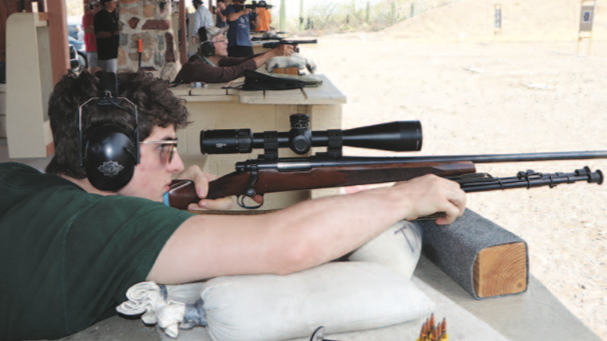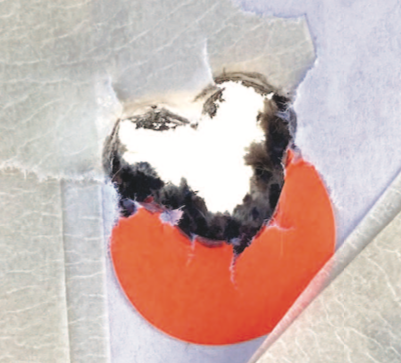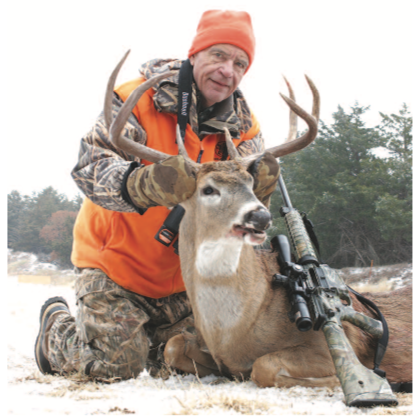
BY STEVE COMUS
What’s with the recent focus on long-range shooting and what does it mean for normal hunters? It could mean a lot, or it might not mean much, depending on individual hunters and the game they pursue.
In recent years, there have been seemingly endless streams of higher-performance gear hitting the marketplace. This is made possible because of computerized design, manufacturing capabilities and the use of high-tech materials.
Bullets are better now, loaded factory ammo is better now, rifles are nominally more accurate across the boards now, sights are better and there are all kinds of digital devices from wind meters to ballistic calculators – all in harmony offering shooters more precision at every level than has ever been possible before.
That’s nice, especially for long-range target shooting where all of the aids can be employed simultaneously and where endless practice can help make things perfect.

But what about the hunter? Does this mean modern hunters must be techy geeks and fully wired before they go afield? Hardly. But what it does mean is that there are handy options that can help at the moment of truth.
Before going further, I need to make one thing perfectly clear: All of the technical devices in the world will not guarantee a clean kill, nor will they make up for bad marksmanship on the part of the hunter. The best they can do is help fine-tune equipment and the situation so good hunters can become either a little better or at least a little more efficient.
There remains the concept of ethics. Simply put, a hunter should only take a shot on game that he or she is confident will dispatch the animal quickly. It is up to the hunter to create a situation in which this happens. If such a situation cannot be engineered, then don’t take the shot.
What all of this means in the context of long-range shooting is that, with some of the higher-performance gear available these days, an individual hunter’s competence can be elevated, at least a bit.
So, what is acceptable hunter competence? As a rule of thumb, the hunter should be able to put bullets into a three-inch circle from the bench. The competent distance is however far away the shots can be taken and still remain within the three-inch circle where the rifle is aimed at 100 yards.
The reason for the three-inch suggestion from the bench is that shots taken on hunts usually have complicating factors – things like being taken from a position or rest that is not as steady as a bench rest. Then there is wind and other environmental factors that come to play on a hunt – all of which tend to enlarge the group. Quickly, the actual accuracy delivered in the field is much less than that from a solid bench.
For those who have the time and access to open shooting areas, it is good to practice shooting at various distances from various positions to determine competency. For such sessions, all shots taken need to fall within a kill zone size part of any target. If it is a deer, then six to eight inches is credible at distance, for elk 14 inches is minimal.

Here is where self-analysis comes into the picture. Don’t figure that just because three of the five shots were in the kill zone that the competence at that distance is right. Every shot needs to find the kill zone, every single time.
Another thing to focus on is the first shot from a cold barrel. That is the shot on a hunt that will determine success. Every single first shot must hit the mark for it to be a competent shot regardless the distance.
Back to long-range things. With all of the above in mind, it is easy to see how a rifle that is a little more accurate, a sight
that is a little more precise and those kinds of things can help the hunter increase the distances of competent shots and/or increase the confidence in shorter shots.
And, since the lethal combination always means putting the right bullet in the right place, today’s high-tech bullets are really helpful because they perform over much longer distances than ever before. Many bullets now work well on very close shots, as well as very long shots and everything in be tween. That’s really nice.
Ideally, a hunter can get to the point where he or she is competent at 500 yards. That doesn’t mean the shot on game should be taken at 500 yards. Never a good idea to back up to make the shot longer.
The concept is that if the hunter is competent at 500 yards, then a 200 or 300-yard shot will be a chip shot and that the odds of missing almost don’t exist – 99 percent or better confidence that the bullet will hit the kill zone.
With that level of confidence, the hunt itself becomes much more enjoyable. The hunter can concentrate on other things like finding the game animal in the first place or the rush that is felt when a game animal drops quickly from a well-placed shot.
Or, viewed from another perspective, imagine a hard hunt in which terrain has been brutal, weather crappy and animals scarce. Then a beautiful animal is spotted and the stalk ensues. The shot is taken and it misses. The animal flees and it is time to start the whole process over again. Whether another animal is found is not guaranteed. That miss may have ended the whole hunt.
Or worse, what about the scenario in which the hunter goes through all of the effort to take the shot and then the animal is hit badly, triggering what could be a lengthy and arduous tracking routine, which may or may not result in finding the animal and dispatching it later. The prospect of losing a wounded animal is not acceptable.
So, there is every reason in the world to stack the deck and go afield, ready to take any reasonable shot with confidence. Then the hardest things to do are to take photos with the bagged animal and process it for good eating later. Shoot straight and be safe.
Steve Comus is a nationally recognized hunting editor with Safari Club International and a WON Guns and Hunting Guns Editor. His column appears every other week in WON and he can be reached at scomus@cox.net.



